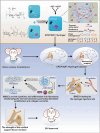Animal models, treatment options, and biomaterials for female stress urinary incontinence
- PMID: 39267906
- PMCID: PMC11390547
- DOI: 10.3389/fbioe.2024.1414323
Animal models, treatment options, and biomaterials for female stress urinary incontinence
Abstract
In the quest to tackle stress urinary incontinence (SUI), the synthesis of cutting-edge biomaterials and regenerative materials has emerged as a promising frontier. Briefly, animal models like vaginal distension and bilateral ovariectomy serve as crucial platforms for unraveling the intricacies of SUI, facilitating the evaluation of innovative treatments. The spotlight, however, shines on the development and application of novel biomaterials-ranging from urethral bulking agents to nano-gel composites-which aim to bolster urethral support and foster tissue regeneration. Furthermore, the exploration of stem cell therapies, particularly those derived from adipose tissues and urine, heralds a new era of regenerative medicine, offering potential for significant improvements in urinary function. This review encapsulates the progress in biomaterials and regenerative strategies, highlighting their pivotal role in advancing the treatment of SUI, thereby opening new avenues for effective and minimally invasive solutions.
Keywords: animal models; biomaterials; stress urinary incontinence; tissueengineered repair materials; urethral bulking agents.
Copyright © 2024 Tan, Li, Li, Kong, Li and Wu.
Conflict of interest statement
The authors declare that the research was conducted in the absence of any commercial or financial relationships that could be construed as a potential conflict of interest.
Figures







Similar articles
-
Injectable biomaterials for the treatment of stress urinary incontinence: their potential and pitfalls as urethral bulking agents.Int Urogynecol J. 2013 Jun;24(6):913-9. doi: 10.1007/s00192-012-2011-9. Epub 2012 Dec 8. Int Urogynecol J. 2013. PMID: 23224022 Review.
-
Exosome Therapy in Stress Urinary Incontinence: A Comprehensive Literature Review.Biomedicines. 2025 May 19;13(5):1229. doi: 10.3390/biomedicines13051229. Biomedicines. 2025. PMID: 40427055 Free PMC article. Review.
-
Applicability of regenerative medicine and tissue engineering for the treatment of stress urinary incontinence in female patients.Neurourol Urodyn. 2019 Aug;38 Suppl 4:S76-S83. doi: 10.1002/nau.24033. Epub 2019 May 16. Neurourol Urodyn. 2019. PMID: 31099087 Review.
-
Treatment of Stress Urinary Incontinence with Muscle Stem Cells and Stem Cell Components: Chances, Challenges and Future Prospects.Int J Mol Sci. 2021 Apr 12;22(8):3981. doi: 10.3390/ijms22083981. Int J Mol Sci. 2021. PMID: 33921532 Free PMC article. Review.
-
Stress urinary incontinence animal models as a tool to study cell-based regenerative therapies targeting the urethral sphincter.Adv Drug Deliv Rev. 2015 Mar;82-83:106-16. doi: 10.1016/j.addr.2014.10.018. Epub 2014 Oct 23. Adv Drug Deliv Rev. 2015. PMID: 25453264 Review.
Cited by
-
Innovations in Stress Urinary Incontinence: A Narrative Review.Medicina (Kaunas). 2025 Jul 14;61(7):1272. doi: 10.3390/medicina61071272. Medicina (Kaunas). 2025. PMID: 40731901 Free PMC article. Review.
References
-
- Alsannan B., Alharmi J., Alrahal F., Al Mansoor S., Tulandi T. (2024). Prevalence and quality of life among overweight and obese women with different severity and types of urinary incontinence. Med. Princ. Pract. Int. J. Kuwait Univ. Health Sci. Centre 33, 47–55. 10.1159/000534651 - DOI - PMC - PubMed
Publication types
LinkOut - more resources
Full Text Sources

